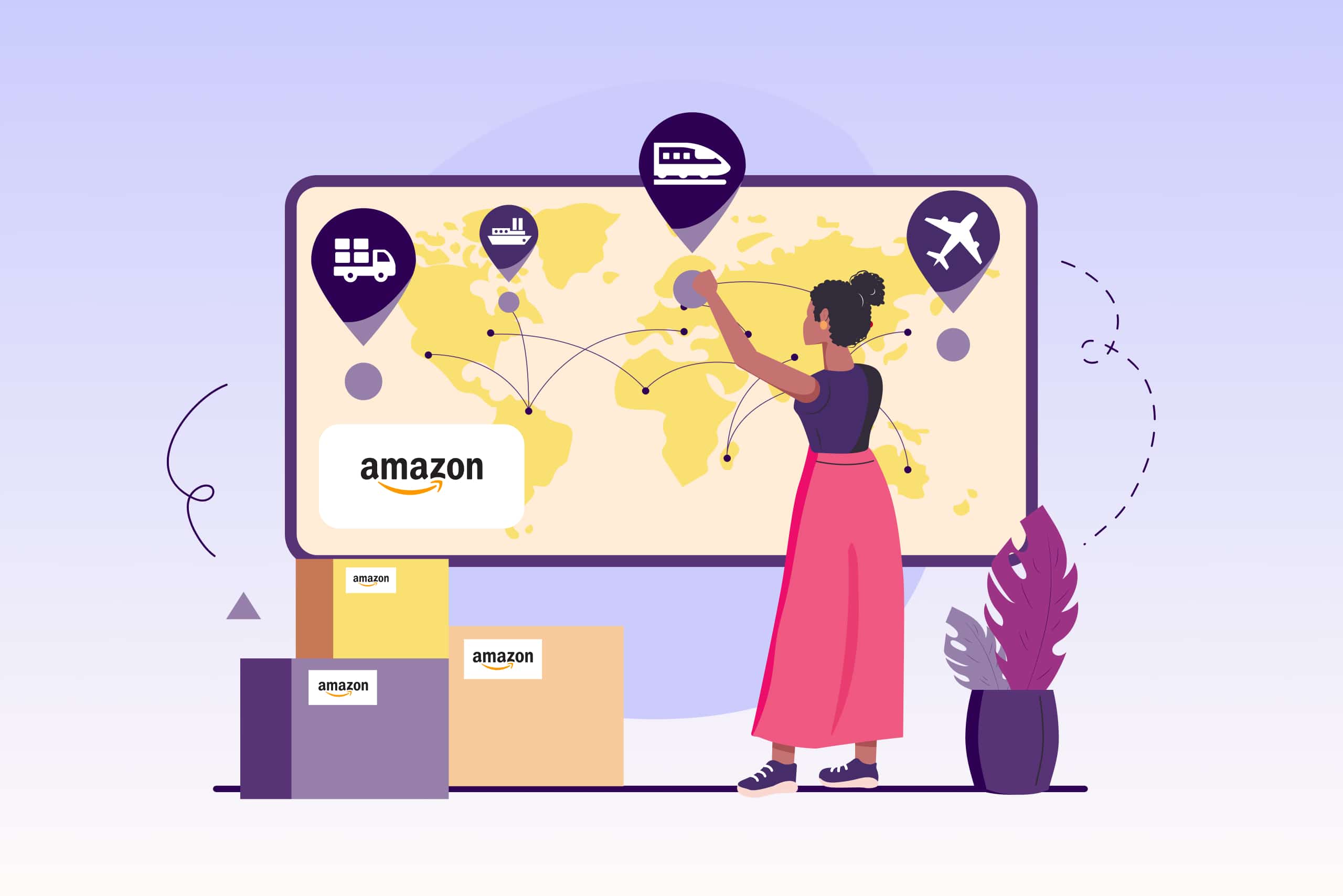After buying something on Amazon, we often take for granted the smooth and efficient delivery of our orders. After a few clicks, our package usually arrives at our doorstep within two days. However, behind the scenes lies a complex system that ensures timely deliveries to millions of customers worldwide. This is made possible by the Amazon supply chain—an essential aspect of their business model.
In 2019 alone, Amazon delivered a staggering 2.5 billion packages, averaging about 20 per household. With its continuous growth, the company has evolved its operations and technology to meet the demands of its customers. Today, the Amazon supply chain has become a crucial selling point for marketplace sellers, especially in peak season providing them with competitive advantages within the eCommerce universe.
Whether you are a small or medium-sized business, or a large corporation, understanding Amazon’s state-of-the-art facilities, innovative technology, and efficient processes is crucial to your logistical success and building a profitable brand.
In this guide, we’ll give you a comprehensive overview of how the Amazon supply chain works, its key components, and how it benefits sellers in the marketplace.
Key takeaways
-
- Amazon’s supply chain is a complex and highly efficient network of systems that enables them to fulfill orders quickly and efficiently.
-
- From its vast logistics network to advanced technology like RFID tracking, Amazon has implemented various strategies to optimize its supply chain for efficiency, cost savings, and customer satisfaction.
-
- While Amazon does not technically manufacture anything itself, its private labeling and white-labeling strategies have allowed it to control the quality and availability of products while also increasing profits.
-
- With the help of third-party services like Trellis, sellers can further optimize their supply chain and maximize their success on the Amazon platform.
Overview of the Amazon supply chain
Amazon’s supply chain refers to the entire process of sourcing, storing, and delivering products to customers. While the chain consists of multiple components, the core foundation of the Amazon supply chain is its advanced use of technology. The company has significantly invested in cloud computing, robotics, machine learning, and artificial intelligence to streamline processes and create a more efficient and cost-effective supply chain.
This enables Amazon to adapt to market demands quickly, forecast customer needs accurately, and provide fast and reliable delivery services. Additionally, Amazon has built numerous fulfillment centers worldwide, enabling them to store products closer to customers and reduce shipping times. They have also introduced Amazon Prime, a subscription service that offers free and fast shipping, further enhancing their supply chain efficiency.
But what exactly does the Amazon supply chain entail? Let’s take a closer look at its key components.
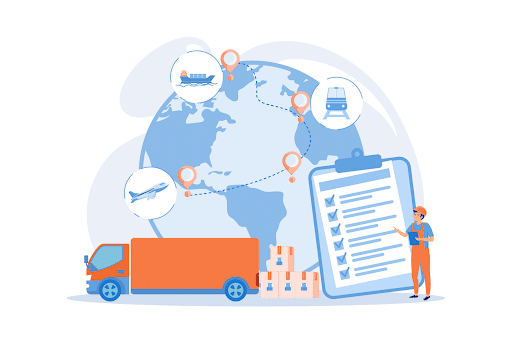
Warehousing
Amazon has built a vast network of fulfillment centers to ensure timely delivery of products. These state-of-the-art warehouses are strategically located near large cities and in remote areas. With over 110 active fulfillment centers in the U.S. alone and more than 175 globally, Amazon’s warehousing system is among the largest in the world.
The fulfillment centers come in different types, each optimized for specific tasks. These include:
-
- Sortable fulfillment centers: These centers, spanning over 800,000 square feet, are responsible for picking, packing, and shipping small items such as books, toys, and housewares. Utilizing advanced technology like Amazon Robotics, workers work alongside robots to efficiently process customer orders.
-
- Non-sortable fulfillment centers: These centers range from 600,000 to 1-million square feet. They handle bulky or larger-sized customer items such as furniture, outdoor equipment, and rugs.
-
- Sortation centers: These centers are responsible for sorting and consolidating customer orders by their final destination, enabling faster delivery. They provide customers with everyday delivery, including Sunday delivery.
-
- Receive centers: At approximately 600,000 square feet, these centers handle receiving large orders and allocating them to appropriate fulfillment centers within the network. They handle quick-selling items or those in high demand.
-
- Specialty buildings: Apart from the main fulfillment centers, Amazon has built several specialty buildings to handle specific categories of items or assist during peak times like the holiday season. These include fresh food warehouses, temperature-controlled storage for perishables, and pop-up fulfillment centers to handle high-demand products.
Delivery
The Amazon supply chain relies on various carriers to get customer orders delivered efficiently. This includes their in-house delivery service, Amazon Logistics (AMZL), which delivers about 46% of its packages. Additionally, they work with other carriers such as UPS, FedEx, and the United States Postal Services (USPS) to transport orders from their fulfillment centers to customers’ doorsteps.
AMZL has its own fleet of delivery vehicles, including vans, trucks, bicycles, and even drones in some areas. This allows for more control over the last-mile delivery process and ensures faster and more cost-effective shipping for Amazon Prime members.
Apart from ground transportation, Amazon also has a fleet known as Amazon Air. This is a network of over 70 cargo planes, with plans to grow the fleet in the coming years. These planes are responsible for delivering packages to the company’s fulfillment centers, enabling them to meet their promise of one-day or two-day delivery for Prime members.
Additionally, Amazon has invested in air cargo services at over 15 airports across the United States, with each jet transporting over 30 containers. This enables them to ship products faster and more efficiently while reducing costs incurred by third-party carriers.
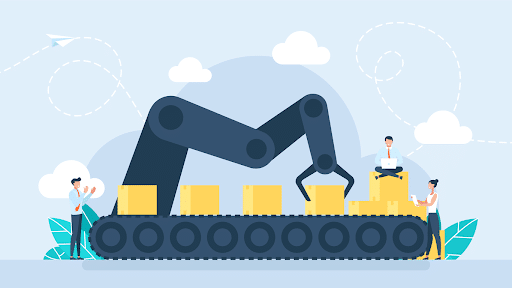
Technology
The use of advanced technology is a crucial factor in the success of the Amazon supply chain. The company has created an ecosystem comprising several interconnected systems, including data centers, distribution networks, and retail storefronts. This enables them to collect and analyze vast amounts of data from numerous sources like customer orders, warehouse operations, supplier information, and delivery routes.
Some of the technologies that help Amazon manage its supply chain include:
Automatic inventory replenishment with fulfillment by Amazon (FBA)
This service allows sellers to store their products in Amazon’s fulfillment centers, and when an order is placed, Amazon handles the picking, packing, and shipping process. In addition to cost savings through Amazon Warehouse Deals (AWD), sellers can also use Amazon’s advanced machine learning algorithms to automatically replenish inventory in fulfillment centers.
This supports expected customer demand by allowing faster speeds through FBA, enabling sellers to fulfill off-Amazon orders through Multi-Channel Fulfillment (MCF). It also optimizes where items are placed in fulfillment centers to meet customer demand and increase the potential for same-day or next-day delivery speeds, resulting in an average 15% increase in FBA unit sales.
Robotics technology
Amazon has been investing in robotics technology to automate processes like picking, sorting, and packing. These robots work alongside employees to streamline operations, reduce human error, and increase efficiency.
One example of this is the Sparrow robot at a facility in San Marcos, Texas, that can pick and sort hundreds of thousands of customer orders using computer vision, machine learning, and AI. Plans are also underway to pair up different robotics systems like Proteus and Cardinal to work together on outbound docks, further enhancing the speed and safety of operations.
Real-time data analysis
With its vast network of warehouses and carriers, Amazon has an immense amount of data that needs to be analyzed. This is where advanced technology like Artificial Intelligence (AI) comes into play.
Amazon uses AI to analyze trends and patterns in data, identify potential issues or delays, and make real-time adjustments to ensure timely delivery. This also helps the marketplace optimize its supply chain for efficiency, cost savings, and customer satisfaction.
Inventory tracking through RFID technology
While RFID technology has been around for decades, Amazon has found innovative ways to use it in its supply chain. One example is Just Walk Out, where Amazon uses RFID tags on products to enable a checkout-free experience. This allows customers to grab clothing and other softline items and simply walk out of the store without waiting in line to pay.
This same technology also allows for more accurate product tracking and inventory management. This, in turn, reduces the likelihood of lost or misplaced products in warehouses.
Manufacturing
Amazon does not technically manufacture anything themselves. Instead, they use a combination of private labeling and white labeling to sell their products. Private labeling involves designing, branding, and producing products under Amazon’s own brand name. At the same time, white-labeling is the practice of sourcing generic or unbranded products from manufacturers and selling them under Amazon’s brand name.
At one point, Amazon boasted over 45 private label brands and more than 243,000 products sold on the platform—ranging from affordable household goods to electronics, clothing, and food. However, they have decided to roll back certain brands to better meet the needs of shoppers.
Amazon also regularly partners with third-party manufacturers and suppliers to sell products under their brand name. This is known as the “AmazonBasics” line, which features various everyday items like batteries, office supplies, and kitchen essentials. This allows Amazon to offer low-priced options to customers while also driving sales and profits.
Through private labeling and white-labeling, Amazon has created a robust manufacturing strategy that allows them to control the quality and availability of their products while also increasing profits through a diverse range of offerings.
Pricing
Pricing is a crucial aspect of the Amazon supply chain. With the vast number of customers and products on its platform, Amazon has implemented a pricing policy that allows for segmentation and optimization to meet customer demand while also increasing sales and profits.
Amazon offers two types of pricing for its customers:
-
- Prime: Prime members pay a monthly or annual fee to receive benefits like free, fast delivery, exclusive deals, and access to Amazon’s vast media library. This encourages customers to purchase more frequently and in larger quantities to make the most out of their membership.
-
- Standard: Non-prime members can choose standard shipping, which typically takes longer and may incur shipping fees.
This pricing strategy allows Amazon to respond quickly to fluctuations in demand, accurately calculate order flow, and efficiently execute orders. It also affects FBA sellers, as high long-term storage fees encourage them to estimate future demand more carefully and avoid overstocking or out-of-stock scenarios.
As an Amazon seller, it’s crucial to understand the marketplace’s pricing policy and how it can impact your inventory management strategy. By keeping inventory levels in check and leveraging opportunities like AWD, sellers can save on storage fees while also optimizing sales through faster delivery speeds for Prime members.
International markets
One of the most significant advantages of selling on Amazon is its global reach. The platform allows sellers to grow their business internationally, regardless of physical location. From North America to Europe, Asia, the Middle East, and beyond, Amazon has a vast network that provides an excellent opportunity for sellers to share their brand to millions of loyal customers.
Some of the key markets on Amazon include:
-
- North America: amazon.com, amazon.ca, and amazon.com.mx
-
- Europe: amazon.co.uk, amazon.de, amazon.fr, amazon.it, amazon.es, amazon.nl, amazon.se, amazon.pl, and amazon.com.tr
-
- Asia: amazon.co.jp, amazon.in, and amazon.sg
-
- Middle East: amazon.ae, amazon.sa, and amazon.eg
-
- Other: amazon.com.au and amazon.br
This global reach allows sellers to tap into new markets, reach a wider audience, and diversify their customer base while leveraging Amazon’s logistics network for timely and efficient delivery.
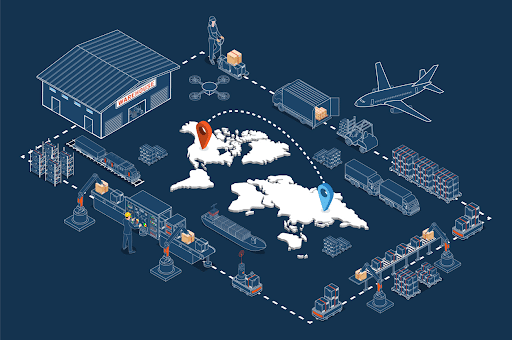
How is the Amazon supply chain so successful?
The success of Amazon’s supply chain management can be attributed to its efficient and highly integrated operations, innovative use of technology, strategic partnerships, and relentless focus on customer satisfaction.
With a vast network of warehouses, transportation services, fulfillment centers, and customer service functions all working together seamlessly, Amazon has created a well-oiled machine that delivers products to customers quickly.
The company’s investments in technology and automation have also played a significant role in streamlining operations and reducing costs, allowing for faster order processing and delivery times.
Moreover, Amazon’s strategic partnerships with third-party carriers, manufacturers, and suppliers have enabled the company to expand its reach globally while also providing a diverse range of products and offerings to customers.
But perhaps the most crucial factor in Amazon’s success is its unwavering dedication to customer satisfaction. The company’s commitment to fast, reliable delivery, excellent customer service, and competitive pricing has earned it a loyal base of customers and sellers alike.
How does Amazon manage logistics?
As one of the largest eCommerce platforms in the world, Amazon’s logistics operations are highly complex. Amazon has developed a sophisticated system to manage the entire supply chain process, from receiving products to delivering them to customers.
Receiving products
While half of the products sold on Amazon are from third-party sellers, the other half are fulfilled by Amazon’s facilities. When goods arrive at an Amazon fulfillment center, they are manually palletized or removed from trailers using a forklift. The shipments are then divided into those from an Amazon facility and those shipped through FBA.
Storing products
Unlike traditional warehouses that store items by type, Amazon’s fulfillment centers use a randomized storage method. Products are stored in yellow-tiered bins and tracked by computers for quick access. This method allows for efficient use of warehouse space and faster order processing. Holding also comes with fees, and Amazon charges based on the product size.
Storage fees
Amazon’s storage fees can vary depending on the type of products, size, and time of the year. Here is a range of storage fees for Amazon FBA 2023:
-
- Inventory storage fees: $0.56 – $3.63 per cubic foot
-
- Unplanned fees: $0.20 – $2.00, per single service, per unit
-
- Fulfillment fees: $3.22 – $179.28 + $0.83/lb above the first 90 lb
-
- Return processing fees: $2.12 – $75.08 + $0.25/lb above the first 90 lb
-
- Long-term storage fees: $1.50 – $6.90 per cubic foot
-
- Removal fees: $0.97 – $13.05 + $1.06/lb above 10 lb
-
- For small businesses looking to keep storage fees reasonable, having comprehensive marketing insights in place is crucial. At Trellis, we can help you with metrics and details related to pricing, advertising, and promotions to ensure your products flow in and out of Amazon warehouses with ease, eliminating unnecessary storage fees.

Picking orders
After placing an order, Amazon uses a combination of humans and robots to fulfill it. The process begins with sending the order to a picker who locates the product in the warehouse using an advanced barcode system. They then place it into a yellow tote, which is then transported by robots to a packing station.
Quality assurance
To ensure efficient operations, Amazon has a rigorous quality assurance process in place. This involves checking that the physical location of items matches the program database and monitoring the correct operation of robots. Any issues are quickly identified and addressed to maintain the smooth flow of operations.
Packing orders
Once the products are picked, they are sent to a packing station. Here, Amazon’s algorithms determine the appropriate box size for each item based on its dimensions and weight. The system also recommends the amount of tape required, reducing wasted materials and saving time for employees.
Items sold by third-party vendors are shipped in their original packaging whenever possible. However, Amazon works with vendors to reduce packaging and promote sustainability.
Shipping orders
After packing, the orders are sent to the shipping department and sorted based on the delivery method and destination. Amazon partners with major carriers like FedEx and UPS, allowing efficient and timely delivery.
Order returns
Amazon’s customer-centric approach extends to its returns policy. The company offers a generous 30-day return window for most products, with some exceptions. Sellers who use FBA are also subject to the same return policies as items fulfilled by Amazon. This allows customers to shop confidently, knowing that if they are unhappy with their purchase, they can easily return it using their Amazon RMA number.
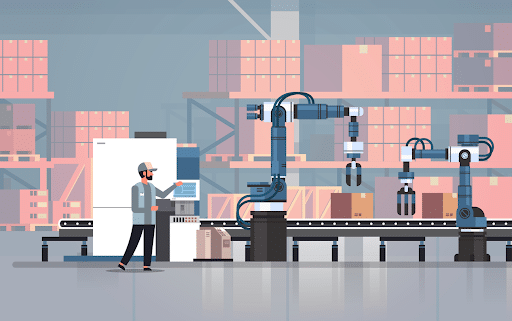
FBA vs. FBM
Fulfillment by Amazon (FBA) and Fulfillment by Merchant (FBM) are two different options for Amazon sellers to manage their orders. Each has advantages and considerations for sellers to weigh before choosing the best option for their business.
FBA (Fulfillment by Amazon)
In FBA, Amazon stores, packs, and ships products on behalf of the seller. This allows sellers to focus on other aspects of their business while Amazon takes care of the logistics. Some key advantages of using FBA include:
-
- Buy Box and Amazon search rank advantages,
-
- Participation in Prime, a program for fast and free shipping within the U.S.,
-
- Less effort is required to provide excellent customer service,
-
- Global fulfillment and comprehensive coverage.
In exchange, sellers pay Amazon for goods storage, fulfillment, and a referral fee. It is essential to keep track of expenses as storage fees can become costly, especially during peak seasons.
Amazon also offers the FBA Onsite program, where sellers can manage their inventory while Amazon takes care of receiving orders and fulfillment. This allows more control over the logistics process, but fees still apply.
FBM (Fulfilled by Merchant)
FBM allows sellers to handle all aspects of storage and fulfillment themselves or through a third-party logistics (3PL) provider. Some benefits of using FBM include:
-
- Improved customer experience, packaging, and branding opportunities,
-
- Complete control over the logistics process,
-
- More cost-effective for large and heavy products.
However, with FBM, sellers do not have access to the same opportunities as FBA sellers. This includes Prime participation and Buy Box advantages. It is also crucial for FBM sellers to have experience and resources in logistics processes to optimize costs.
How does the Amazon supply chain benefit sellers?
Understanding how the Amazon supply chain works can give sellers an edge over their competitors. It gives them better shipping times, savings, and control over their operations.
Faster shipping times
By using Amazon’s fulfillment network, sellers can take advantage of faster shipping times to meet customer expectations. With FBA, products become eligible for Prime, allowing customers to receive their orders within one to two days. This not only improves the customer experience but also gives sellers a competitive advantage.
Cost savings
The Amazon supply chain can also provide cost savings for sellers. By using FBA, they don’t have to worry about storage or fulfillment costs, which can be significant expenses for small and medium-sized businesses. Additionally, Amazon has negotiated lower shipping rates with carriers due to their high volume of shipments, allowing sellers to save on shipping costs.
More control
For sellers who choose FBM, Amazon’s fulfillment centers and advanced logistics processes provide an efficient way to manage their inventory. By using Amazon’s warehouses, they can store products closer to customers, resulting in faster delivery times. With the FBA Onsite program, sellers can have more control over their operations while benefiting from Amazon’s resources and expertise.
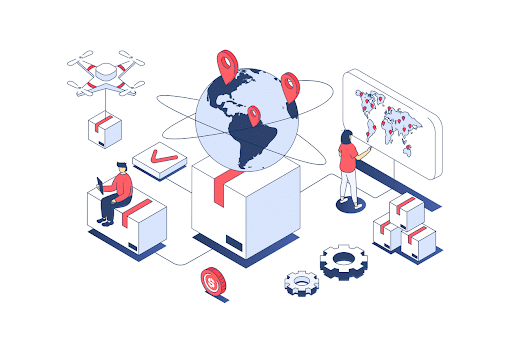
Final Thoughts
Understanding how the Amazon supply chain works is crucial for sellers looking to succeed on the platform. By utilizing Amazon’s resources and expertise, sellers can benefit from faster shipping times, cost savings, and more control over their operations. Whether they choose FBA or FBM, Amazon’s advanced fulfillment network provides an edge for sellers to stand out in the competitive eCommerce market.At Trellis, our powerful eCommerce advertising software and experienced team can supercharge your merchandising and drive profitable growth for your business. To learn more about ways we can lend a hand when it comes to your online brand, reach out to us.



